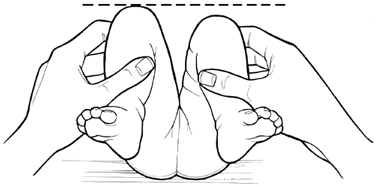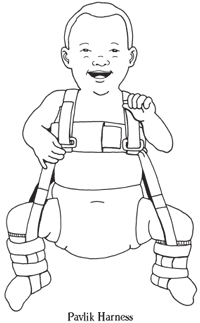Hip dysplasia (developmental dysplasia of the hip) is a condition in which a child's upper thighbone is dislocated from the hip socket. It can be present at birth or develop during a child's first year of life.
Hip dysplasia is not always detectable at birth or even during early infancy. In spite of careful screening of children for hip dysplasia during regular well-child exams, a number of children with hip dysplasia are not diagnosed until after they are 1 year old.
Hip dysplasia is rare. However, if your baby is diagnosed with the condition, quick treatment is important.
What causes hip dysplasia?
No one is sure why hip dysplasia occurs (or why the left hip dislocates more often than the right hip). One reason may have to do with the hormones a baby is exposed to before birth. While these hormones serve to relax muscles in the pregnant mother's body, in some cases they also may cause a baby's joints to become too relaxed and prone to dislocation. This condition often corrects itself in several days, and the hip develops normally. In some cases, these dislocations cause changes in the hip anatomy that need treatment.
Who is at risk?
Factors that may increase the risk of hip dysplasia include
- Sex—more frequent in girls
- Family history—more likely when other family members have had hip dysplasia
- Birth position—more common in infants born in the breech position
- Birth order—firstborn children most at risk for hip dysplasia
Detecting hip dysplasia
Your pediatrician will check your newborn for hip dysplasia right after birth and at every well-child exam until your child is walking normally.
During the exam, your child's pediatrician will carefully flex and rotate your child's legs to see if the thighbones are properly positioned in the hip sockets. This does not require a great deal of force and will not hurt your baby. 
Your child's pediatrician also will look for other signs that may suggest a problem, including
- Limited range of motion in either leg
- One leg is shorter than the other
- Thigh or buttock creases appear uneven or lopsided
If your child's pediatrician suspects a problem with your child's hip, you may be referred to an orthopedic specialist who has experience treating hip dysplasia.
Treating hip dysplasia
Early treatment is important. The sooner treatment begins, the simpler it will be. In the past parents were told to double or triple diaper their babies to keep the legs in a position where dislocation was unlikely. This practice is not recommended. The diapering will not prevent hip dysplasia and will only delay effective treatment. Failure to treat this condition can result in permanent disability.
If your child is diagnosed with hip dysplasia before she is 6 months old, she will most likely be treated with a soft brace (such as the Pavlik harness) that holds the legs flexed and apart to allow the thighbones to be secure in the hip sockets. 
The orthopedic consultant will tell you how long and when your baby will need to wear the brace. Your child also will be examined frequently during this time to make sure that the hips remain normal and stable.
In resistant cases or in older children, hip dysplasia may need to be treated with a combination of braces, casts, traction, or surgery. Your child will be admitted to the hospital if surgery is necessary. After surgery, your child will be placed in a hip spica cast for about 3 months. A hip spica cast is a hard cast that immobilizes the hips and keeps them in the correct position. When the cast is removed, your child will need to wear a removable hip brace for several more months.
Remember
If you have any concerns about your child's walking, talk with his pediatrician. If the cause is hip dysplasia, prompt treatment is important.
Copyright © 2003 American Academy of Pediatrics. All rights reserved.
